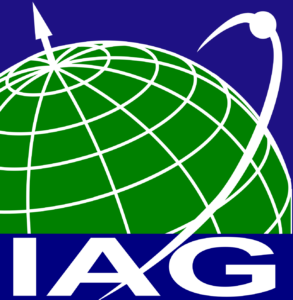Working Group of Sub-Commission 2.1
JWG 2.1.1: Development of the International Terrestrial Gravity Reference Frame
(joint with IGFS, BGI, IGETS)
Chair: Hartmut Wziontek (Germany)
Vice-Chair: Sylvain Bonvalot (France)
Terms of Reference
One task of IAG’s Commission 2 “Gravity Field” is the establishment of the International Terrestrial Gravity Reference System and Frame (ITGRF). These activities are motived by the IAG Resolutions No. 2 of 2015 (IUGG General Assembly Prague), No. 4 of 2019 (IUGG General Assembly Montreal) and No. 1 of 2023 (IUGG GeneralAssembly Berlin). The IAG Sub-Commission 2.1 “Terrestrial gravimetry for the needs of geosciences and metrology” promotes consistency and compatibility of gravity and gravity gradient datasets and assessment of their accuracy. The International Gravity Field Service (IGFS) coordinates the servicing of the geodetic and geophysical community with gravity field related data, software and information. The infrastructure of IGETS, specifically stations operating superconducting gravimeters, provides a basis for reference stations of the ITGRF. The ITGRF as a modern and precise absolutegravity reference frame will not only contribute to the establishment of the Global Geodetic Reference Frame (GGRF) of the UN, but will also serve as a long-term and precise gravity reference for the IAG Global Geodetic Observing System (GGOS).
Objectives
- Within IAG Sub-Commission 2.1 “Terrestrial gravimetry for the needs of geosciences and metrology” the realization of the International Terrestrial Gravity Reference Frame (ITGRF) will be continued. The ITGRF is the realization of the International Terrestrial Gravity Reference System (ITGRS). According to IAG Resolution No. 1 of 2023, the ITGRS is defined by the observation of the instantaneous acceleration of free fall, the traceability of these observations to the International Systemof Units (SI), and a set of conventional corrections for the time independent components of gravity effects. The ITGRF as the realization of the ITGRS is based on observations with absolute gravimeters (AG) which are monitored at reference stations, and during comparisons. The ITGRF further recommends a set of conventional models for the correction of temporal gravity changes. Finally, the ITGRF demands a compatible infrastructure accessible to end-users, as expressed by IAG Resolution No. 4 of 2019.
- The JWG focuses on the establishment of such infrastructure in cooperation with IGFS, GGOS, international and national institutions, agencies, and governmental bodies. This infrastructure should consist of reference stations on the national level for the monitoring of AGs. On the international level, comparison stations will provide the facilities to check the compatibility of AGs, and core stations will link to space geodetic techniques (ITRF) and the International Height Reference Frame (IHRF).
- The absolute gravity database “AGrav” which is a permanent component of the International Gravimetric Bureau (BGI) services will be developed to a central inventory to document all ITGRF stations and related AG observations.
- A close cooperation with the International Geodynamics and Earth Tide Service (IGETS) supports the continuous monitoring at the gravity reference stations. The collaboration with the Working Group on Gravimetry of the Consultative Committee on Mass and Related Quantities (CCM-WGG) at BIPM establishes a link to metrology and supports the traceability of the AG observations.
- The activities should be further aligned with the JWG on the Implementation of the International Height Reference Frame.
Members
Hartmut Wziontek (Germany); Chair
Sylvain Bonvalot (France); Vice-Chair
Mauro Andrade de Sousa (Brazil)
Ezequiel Antokoletz (Germany)
Mirjam Bilker Koivula (Finland)
John Crowley (Canada)
Przemysław Dykowski (Poland)
Andreas Engfeldt (Sweden)
Alessandro Germak (Italy)
Jaakko Mäkinen (Finland)
Urs Marti (Switzerland)
Jack McCubbine (Australia)
Vojtech Palinkas (Czech Republic)
Victoria Smith (UK)
Ludger Timmen (Germany)
Claudia Tocho (Argentina)
Christian Ullrich (Austria)
Derek van Westrum (USA)
Shuqing Wu (China)
Koji Matsuo (Japan)
Arturo Villar García (Spain)
Corresponding Members
Jonas Ågren (Sweden)
Daniel Barnes (USA)
Henri Baumann (Switzerland)
Denizar Blitzkow (Brazil)
Jean-Paul Boy (France)
Ana Cristina O. Cancoro de Matos (Brazil)
In-Mook Choi (Korea)
Neda Darbeheshti (Australia)
Renaud Degoy (France)
Alfredo Esparza (Mexico)
Alessio Facello (Italy)
Germinal Gabalda (France)
Walter Humberto Subiza Piña (Uruguay)
Domenico Iacovone (Italy)
Shuanggen Jin (China)
Janis Kaminskis (Latvia)
Jeff Kennedy (USA)
Márta Kis (Hungary)
Martin Lederer (Czech Republic)
Camilo Matiz (Colombia)
Leidy Johanna Moisés Sepúlveda (Colombia)
Per-Anders Olsson (Sweden)
Tomasz Olszak (Poland)
Andrea Prato (Italy)
Rene Reudink (Netherlands)
Laura Sanchez (Germany)
Heping Sun (China)
V.M. Tiwari (India)



